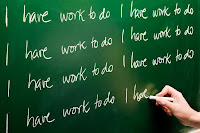I’m a big fan of Steven Covey’s 7 Habits of Highly Effective People. My favorite habit (yes, I have a favorite!) is Habit 3: Putting First Things First. The Habits are designed to be mastered sequentially and this one comes after learning to be proactive and to begin with the ending in mind. By Habit Three, the reader is ready to start living their priorities. This is the time to bring the most important things to the forefront.
In order to put first things first, you have to have the time. What things am I talking about? Exercise, eating healthy, quality time with family, friends and the significant other, prayer and meditation, professional development, hobbies, writing the Great American Novel, these are the things that we say we value but we often put aside. Why? Most often, we simply don’t have the time … or so we say. Take a moment and look up at the banner of this blog. What does it say? LOSE THE EXCUSES! More often than not, not having time is just that, an excuse.
Covey has a simple but dramatic four quadrant square that illustrates where we are currently spending our time and how we can reallocate it to make time for the things that matter most. The quadrant tracks two concepts – urgency and importance.
Quadrant One is the Quadrant of the Procrastinator. Things in this quadrant are both urgent and important. This quadrant is where we are when we are rushing to get that report in by the deadline or stay up all night cramming for the test. It is the quadrant of car trouble, and even heart attacks.
Quadrant Two I’ll talk about last.
Quadrant Three is the Quadrant of the Yes Man. Things in this quadrant are urgent but not important. We are in this quadrant when we let interruptions (chatty co-workers, non-urgent phone calls, immediately answering non-essential emails) take us away from what is more important. Some meetings fall into this category and things that are important and urgent to others but aren’t important to us appear here too.
Quadrant Four is the Quadrant of the Slacker. Things in this quadrant are neither urgent or important. Some time spent surfing the net, watching TV or napping is a good thing. We all need down time and relaxation. However, if you are spending too much time here, it is a problem.
Quadrant Two is the Quadrant of the Prioritizer. Things in this quadrant are not urgent but they are important. This is where we should spend more of our time. This is the quadrant of planning, relationship building, exercise, planning, and prevention. The lack of urgency sometimes makes these important tasks take a back seat to Quadrant 1.
However, spending more time in Quadrant Two reduces the amount of time we spend in the first quadrant. A little planning and time management and the adrenaline-filled rush to complete the report or the caffeine-fueled cramming session could have been avoided. A little preventive car maintenance could have eliminated the car trouble. It’s possible that making time to exercise, prepare healthy meals and visit the doctor, the heart attack might not have happened.
We can also work on spending less time in Quadrants Three and Four. Begin managing your interruptions. Hold people who drop by to a time limit. Let them know you have five minutes or so to talk and then you have to get back to work. Five minutes later, give them a better time to continue the discussion, if necessary. Use technology to your advantage. Check your Caller ID and voicemail. You don’t have to answer every phone call. Return calls when you have the time. Likewise, set a time to return emails. Use the flag feature to keep them from falling through the cracks.
It is easy to end up spending too much time in Quadrant Four. After all, time flies when you are having fun! Give yourself a set amount of time for your activity and then use a timer to reinforce that.
Make the time for the things that matter most. This is where life is lived and memories are made.


















